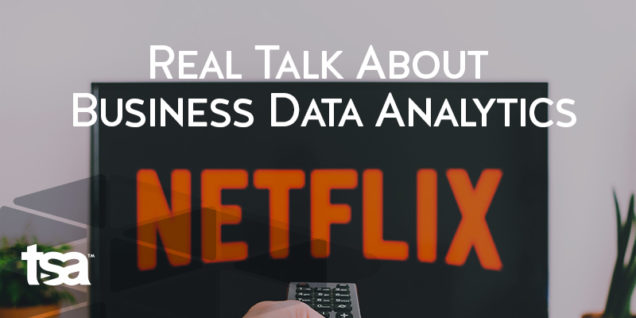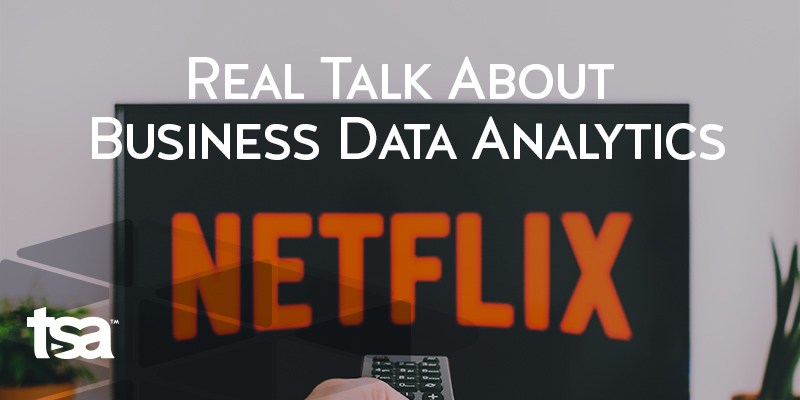“The majority of companies don’t realize that they can answer many of their business questions with the data that they already have. It’s just a question of being able to access it.” — TSA Enterprise Solutions Architect, Corey Gary
In a previous blog post, we discussed the three basic levels of analytics—descriptive, predictive, and prescriptive—and explained how this technology is architected to break down massive amounts of raw data into more manageable, actionable chunks. With modern business data analytics, researchers and technologists no longer have to “drink from the fire hose” of raw data.
However, it is important to establish that analytics is not simply a “wind-up-and-let-it-go” apparatus; it requires more resources than its current IT buzzword-status may have you believe. As a result, many companies are underutilizing the data at their disposal.
And while SMBs don’t have the IT bandwidth that Fortune 500 corporations do, it is beneficial to observe how these larger companies are leveraging business data analytics for their success.
The Inaccessible Data Stream
Gartner’s “Cool Vendors in Data Management” 2017 report states that “real-time data integration and access to data remain core challenges for [those] looking to modernize data management ecosystems.” Moreover—and most shocking—the Harvard Business Review reports that, for the most part, “less than half of an organization’s structured data is actively used in making decisions—less than 1% of its unstructured data is analyzed or used at all.”
Because of the “unlimited storage” mentality of cloud users, some companies have started collecting and storing a historical record of business data in hopes of future analytical advancement. Which is, arguably, a step in the right direction, but idling, uninterpreted, raw data does little to strategically inform the company that pays for its storage and security.
Let’s look at a particular situation where a large company accessed, analyzed, and applied the correlations they found from their raw data streams.
How to Get the Answers You Need from the Data You Already Have
Because they have the in-house teams and the OPEX to do so, large corporations like Netflix have been successfully leveraging end-user data for some time now. For example, Netflix analyzed end user preference data from before 2012 and discovered that a great majority of their audience at the time:
- Liked the actor Kevin Spacey
- Enjoyed movies by producer Beau Willimon
- Gravitated towards political dramas
Thus, “House of Cards” was born from that viewership analysis, and it quickly became one of the most popular Netflix shows to date.
But that perfect political drama recipe didn’t just magically appear on the CEO’s desk by itself.
Data Analytics is Difficult Even for the Largest Company’s IT Team
In order for Netflix to make sense of the constant flood of viewing data, the streaming company architected an analytics platform that could handle the influx.
To accomplish this, Netflix had to hire a small army of qualified developers to create application environments large enough to meet end-user demand. Not only that, they needed to bankroll a team of data scientists who wrote and implemented the necessitated algorithms as well as interpreted the generated analytics reports into actionable data.
And it worked. For a time.
Although Netflix poured substantial IT and analytics resources into the “House of Cards” initiative, financial and brand-associated risk still remained. There is always a fair chance that data is misinterpreted or becomes irrelevant due to changing end-user desires. In this case, although the data pointed to a popularity outcome for a show like “House of Cards,” predictive analytics are, obviously, not a 100% guarantee. A fact that we have clearly seen in the recent fallout over Spacey’s moral misconduct—a circumstance that no algorithm or analytics platform could have foreseen. The company’s initial reaction was to cancel the show entirely to avoid public backlash.
But since 2017, algorithms and analytics have played their part in Netflix’s 2018 decision to continue the series into a 6th season. In the end, Netflix chose to trust the real world analytics in front of them yet again.
So, What About SMBs?
SMBs collect data, but that’s as far as many have gotten. They’re not Netflix after all.
This Netflix-level of data interpretation and analysis is overwhelming, especially for smaller companies who aren’t looking to produce the world’s next hottest TV show; they simply are looking to gain an extra edge over their industry competition. Unfortunately, many companies have little idea how to manage the torrents of business data without compromising their budget and workforce resources. And those who attempt it anyway (and by themselves) only manage to leverage that 1% mentioned above.
Thankfully, the tech industry is making great strides in this area as engineers and researchers alike are fighting to more efficiently manage and process the exponential growth of end-user data. And, simultaneously, tech companies, like TSA and HPE, are working diligently to democratize business data analytics platforms and services to make it easier for SMBs to derive tangible value from their data.
Quit going it alone and don’t let your data sit idle. There are answers to be had, and TSA will help you get there.

